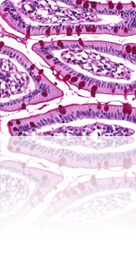

The mission of the Gastroesophageal Cancer Program is to advance our knowledge of the pathogenesis, prevention, prognosis and treatment of gastroesophageal malignancies to reduce the incidence, increase survival and improve the quality of life of individuals affected by these tumours.
The program has two investigative themes:
In 1989 Dr. Manuel Pera and his group described for the first time (Cancer Res 49:6803,1989) inducing areas of columnar metaplasia and adenocarcinomas in the oesophagus of rats after the development of a chronic reflux of duodenal content by means of an oesophagojejunal anastomosis and administration of the carcinogen 2,6-DMNM. In this first study, it was demonstrated that biliopancreatic reflux, which is very prevalent in Barrett’s oesophagus patients, acted in the animal model as a promoting mechanism of oesophageal carcinogenesis when the number of tumours increased and at the same time produced a hystopathological change that made way for the development of carcinomas with glandular differentiations. Later studies with the same animal model demonstrated that chronic reflux (> 20 weeks) of biliopancreatic secretions towards the oesophagus per se, without concomitant administration of the carcinogen is sufficient to induce the development of areas of glandular metaplasia and adenocarcinomas (Carcinogenesis 21:1587, 2000).
Our group offered the hypothesis then that when acted upon by components of duodenal reflux, the keratinocytes of the basal layer of the squamous epithelium of the oesophagus would have the potential to undergo a transdifferentiation process towards acquiring a columnar phenotype. This data support the hypothesis on the origin of Barrett’s oesophagus in humans from cells of the oesophagus itself. Recently we have demonstrated that the oesophageal keratinocytes in rats with chronic reflux action express the Cdx2 transcription factor that is a determiner for the apparition of an intestinal phenotype, both in the stomach (intestinal metaplasia) and in the oesophagus (Barrett’s metaplasia) (J Gastrointest Surg 11:869, 2007). Likewise, Cdx2 regulates the transcription of other markers of intestinal differentiation, such as Muc2 and, in this sense, we have observed the expression of Muc2 in those areas of squamous epithelium with columnar differentiation.
In line with the translational research component, Dr. Pera’s laboratory is primarily interested in characterising the phenotypic changes that occur in the squamous epithelium of the proximal oesophagus exposed to a mixed reflux of bile and acid, and its evolution towards the development of cardiac epithelium and intestinal metaplasia with goblet cells in a clinical model of Barrett’s oesophagus developed after a subtotal oesophagectomy and reconstruction with an oesophagogastrostomy. It is also crucial to determine whether the squamous epithelium of patients with Barrett’s oesophagus is more prone to undergoing a process of transdifferentiation toward the acquisition of a columnar phenotype. More.
Coordinator:
Manuel Pera(ELIMINAR)
Tel:
93 248 33 25
Fax:
93 248 34 33
Pg Marítim, 25-29
08003 Barcelona
© Institut Hospital del Mar
d'Investigacions MèdiquesLegal Notice and Privacy Policy | Cookie Policy | Site Index | Accessibility | Find Us | Contact